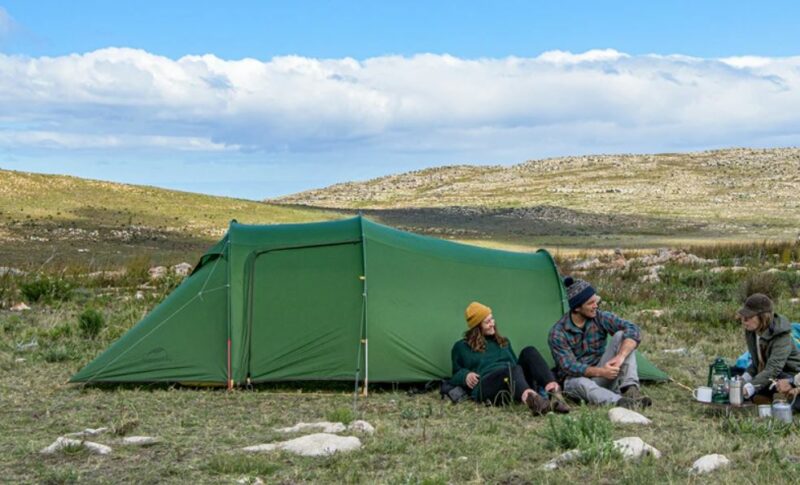Here you have a short description of technology used in the construction of the so-called silnylon tents and silpoly tents. So keep reading and bookmark this text for reference.

So what is a silnylon tent and what is a silpoly tent?
This is about coating used on the tent fabric. As you surely know, most frequently used material for coating is polyurethane. But this type has some downsides, so ultralight advanced tents that are designed to be carried on the trail sometimes have silicone used.
So dependent on what the basic tent material is, nylon or polyester, you can have a combination that is described as silnylon tent and silpoly tent.
Silicone is used for tent coating because of its excellent features, it is chemically inert and extremely hydrophobic. The first property is due to the fact that this is an inorganic polymer built around a highly stable Si-O bond. This is what makes it hydrophobic as well. The top picture above shows one silnylon tent, the Naturehike Opalus 2 Tent.
Have you noticed that tents with silicone coating are usually with a modest official waterproof rating? This is because its thickness applied to tent’s fabric is quite limited. This is not so with a PU coating where you can add a layer upon layer and have as much HH (waterproofness) as you want. But this makes the fabric heavy of course.
So with silicone this is usually around 1500 mm, but you will rarely need more. In fact, there are several other factors that may make tent leaking. If seams are not properly taped, the tent will leak no matter what kind of coating you have.
What is Sil/Sil and Sil/PU coating?
The term sil/sil means that manufacturer has applied silicone on both sides of the fabric. This is a great construction because of dramatically reduced water soaking. So the tent dries faster, this is also good for mold resistance, there is no hydrolysis (breakdown of the coating) so the tent will last much longer.
The term sil/PU implies a combination of silicone and polyurethane used separately on each side of the fabric. PU coating is inferior to silicone coating so why would they make such a combination? Well, keep reading.
Is a silicone coated fabric fire retardant?
The main reason for a sil/PU combination is probably fire-retardance. Namely, silicone cannot be mixed with fire-retardant chemicals and without this the tent cannot achieve CPAI-84 standard. This is why they add PU on one side, and PU can be mixed with fire retardants.
Is a silicone coated fabric stronger?
The short answer is yes, a silicone coating makes the fabric more tear resistant. In this sense, tear strength of a sil/PU coated fabric is inferior to the same sil/sil coated fabric. This is because PU gets in between the yarns and make them fixed. This is normally described as yarn slippage effect. So the yarns will not move to the side when pressure is applied into a narrow spot. In this case the yarn may easier get damaged than when it can move to the side.
But see how it is with silicone. I mentioned yarn slippage, so imagine, silicone is a great lubricant. So in the case of a narrow pressure spot, yarns can easier slide to the side and over each other, and they might not get damaged under force.
In other words, the best combination for an increased tear strength is clearly a sil/sil coating. But a fabric with such coating is normally always more expensive than a PU coated fabric.
Can a silicone coated tent fabric be seam-taped?
The answer is not so simple. It cannot be seam taped in the usual way. For a silicone coated fabric you need a silicone-based sealant. So is there any? No worry, if you go to Amazon you will see them many. But in the case of a sil/PU coating, the PU side can be taped with the usual PU based tapes.
This is why you can see sil/sil fabrics with inverted seams, and the so-called double needle lap-felled that apparently do not need seals and tapes. MSR is known for their Xtreme Shield design that uses a poly-cotton thread that swells when wet. This means that taping is not necessary, well, up to a point.
But what about silpoly tents?
Well, everything is the same with respect to coating, so you can have the same sil/sil, PU, and sil/PU combinations explained above.
But the fact is that such silpoly tents are rare. I am not sure really why this is so. Nylon material is stronger than polyester so this may be one reason. This is why you may see nylon used in tent’s floors while the tent fly is polyester. You can see this in MSR Elixir tents. But there are so many polyester tents out there.
Perhaps the answer is in the fact that polyester is hydrophobic as it is, so it does not need silicone to improve this particular feature. On the other hand nylon is hydrophilic and it becomes stretchy when wet, so silicone improves it. In any case, you have such a silpoly material used in the Yama 1P Cirriform DW shelter.
Thank you for reading. You might want to bookmark this site and come again, I add here texts regularly and this will keep you informed.
Leave a Reply